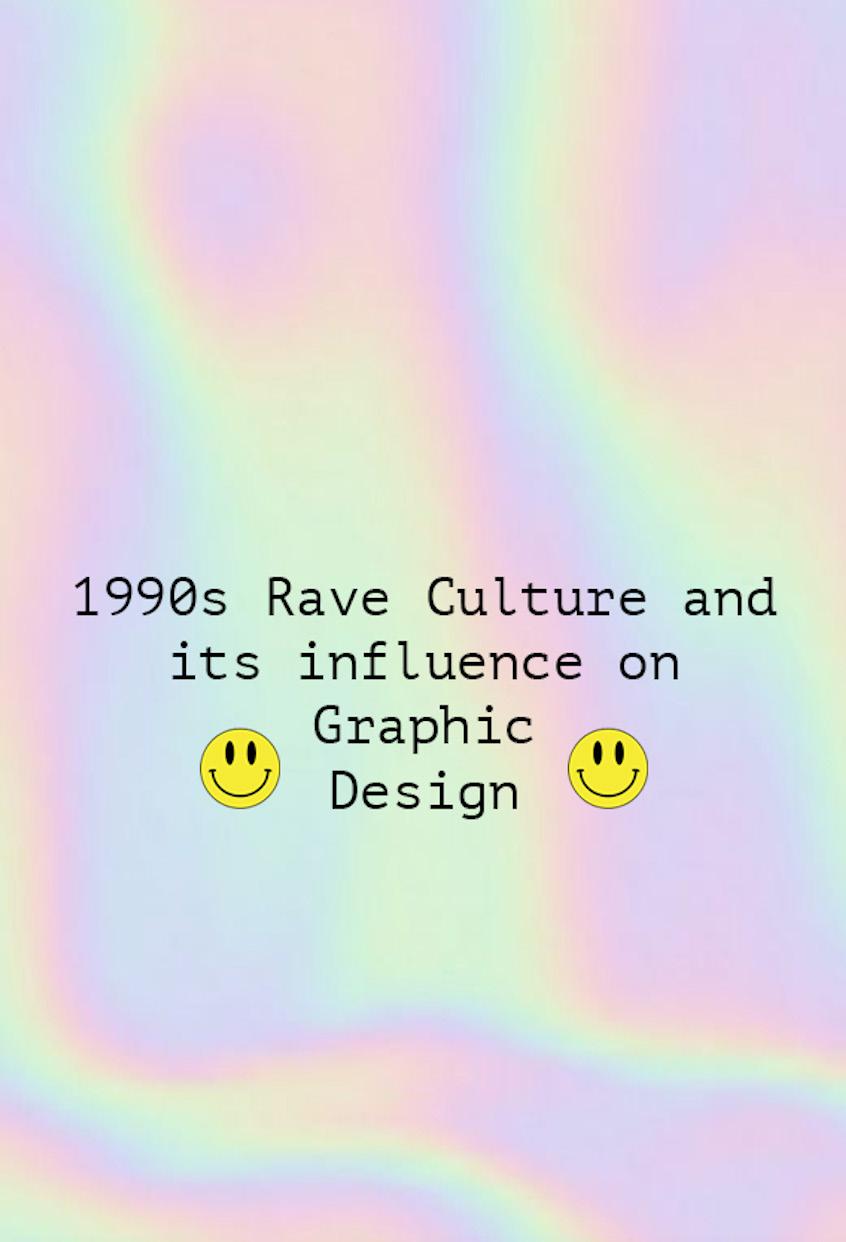
Contents
Introduction 1 Literature Review 2 Subcultures 2 Rave Culture Clubbed Background Research Phenomenology Sanctuary Graphic Design Research Methods Qualitative Research Participant Observation Ethnography Aims & Objectives Project Development Conclusion 3 12 16 20 24 25 26 27 28 33 34 35 37 References Image References Appendix 38 48 39
Throughout this study, I will examine the late 80s to early 90s youth cultural movement: rave culture, and its influence on graphic de sign. I will examine the development of subcultures, the emergence of rave culture, and discusses my research methodology suited to my practice. By investigating different research methodology not only will I research into my topic, but I will use this as inspiration and inferences towards my final major project. I will also explore whereabouts rave culture sits now, capturing and tapping into the real scene of modern-day raves. I will investigate the impact 90s graphic design has on contemporary artists and designers. For my final major project, my aim is to re-create rave posters, flyers, tickets, and stickers from the 90s free party scene, using inspi ration I will collect through my research throughout this project.
Introduction
1
Literature Review
Subcultures
The emergence of this thing called “youth culture” is a distinctly 20th-centu ry phenomenon; the collision of increased standards of living, more leisure time, the explosion of post-war consumer culture, and wider psychological research into ad olescents all contributed to the formation of this new social category defined by age (Milestone, 1999). Culture is a particular way of life which expresses certain mean ings and values not only in art and learning, but also in institutions and ordinary behav iour. The analysis of culture, from such a definition, is the clarification of the mean ings and values implicit and explicit in a particular way of life, or a particular culture (Hebdige, 1981). Youth rebellion and mu sic has long been linked with Britain’s sar torial history; from ostentatious radicals embracing new levels of swank vulgarity, to the DIY garbs of punk and brazenly bold colours of the 1980s new wave, the incep tion of subcultures has provided and out let for expressive fashion and a space for communities to flourish (Rowland, 2021).
Youth culture has always been a big interest of mine, since studying through out my undergraduate course, I’ve enjoyed learning about the culture. I would scroll endlessly on Pinterest and the internet looking for photographs, blogs, and stories based on youth culture to educate and fuel
and inspire my creative practice. From the fashion, style, and music, youth culture in fluences my practice, as the groups show their sense of belonging and express their individuality through their style and social boundaries. Youth culture has constantly been evolving, developing a huge impact on lifestyles, interests, and arts.
2
Rave Culture
Depending on one’s generation, the word “rave” elicits varied reactions. From the late 80s to, early 90s, a series of events from multiple scenes and cultures swept across the world. Illegal raves took place in abandoned warehouses, forests, fields, and other locations, and by 1987, acid house was a firmly established part of the Brit ish cultural scene (Walker, 2020). Raves usually consisted of a great DJ, strobe lights, peace, love, and dance, and became the epicentre of freedom of expression. Every weekend young people searched the country to find illegal par ties. Raves could be organised for weeks; however, the location was left until last minute to be revealed to prevent detection by the police. Service stations were the main meet-up points for people to gath er to identify the location, and from there the groups would disperse into the given direction. From there, the night had begun, thousands would gather and party all night replacing their worries with hedonism and euphoria. They would party until the ear ly hours of the morning, drive home, and repeat the following weekend. By 1991 it was a crowded marketplace, with names like Dreamscape, Universe, and Percep tion. With the music also settling into clubs while the free party scene raged on, it’s re markable how many people were out there chasing a good time (Warwick, 2021).
3
“We just have fun and get people together. We serve a community” (Jones, 2020).
4

Figure 1 5
“A rave (from the verb: to rave) is a large dance party featur ing performances by DJs and occasionally live performers playing electronic music, particularly electronic dance music (EDM). The music is amplified with a large, powerful sound reinforcement system, typical ly with large sub woofers to produce a deep bass sound. The music is accompanied by laser light shows, projected images, visual effects and fog machines. The word “rave” was first used in the late 1980s to describe the subculture that grew out of the acid house movement” (Omri, 2016).
6
When researching websites, articles, and books, I discovered the word “PLUR” multiple times, which represents “peace, love, unity, and respect”. Peace, love, and unity; add respect into the fold, and you get the acronym PLUR. PLUR became of the biggest reasons people started flocking to raves — they were chill plces where what you wore and what you looked like didn’t matter. All that mattered was the musi And the fun (Saylor, 2019).
Trance music is typically the music played at raves, as it is a profound type of music that enhances emotions as it is up lifting and produces a feeling of an altered state. The constant rise and fall of the elec tronic beats build anticipation and emo tion, releasing dopamine from the brain providing you with energy and happiness. I find rave culture exciting and in spiring, therefore, I decided to educate my self further on the topic. Although I have a good knowledge of the subculture from my previous studies, I was introduced to Mark Leckey through a previous module, creative studio. Mark Leckey is a new art ist to me, once I’d researched into him it opened a whole new world of rave culture, I was previously unaware of. Fiorucci Made Me Hardcore was a roughly chronological overview of 30 years of British nightclub culture, from the speedy Northern Soul all-nighters of the 70s to 90s field raves via
the casuals culture which Mark associated with as a teenager growing up in Liverpool. Through his work, Mark Leckey speaks of class, technology, and pop culture, exorcis ing emotion in all its messy beauty along the way (Stone, 2017). Leckey’s work is inspir ing to me as it reflects his emotion. Through out creating different mediums, my emotion and aesthetic is expressed in everything I do. Leckey states that “everything I make is a response to what I am anxious about, what I’m feeling” (Stone, itsnicethat, 2017).
Communicating emotion through art is extremely important, especially with a topic such as rave culture, where the scene thrives off euphoria. To convey nostal gia, freedom, and desire through my work I need to consider the colour, symbolism, and composition. Any colour can be used to create artwork that represents rave cul ture, as artwork created in the 90s was a mix of anything and everything. ‘Simple colourways, bold typography, bold splurg es of colour, conjuring images, clean lines, pop-art inspired, bold confidence’ (Bill Brewster, clubbed, 2018), these are just a few examples of the way the visual com munication is detailed throughout the book Clubbed, including logos, posters, flyers, etc.
In terms of symbolism, the famous smi ley face symbol became the iconic graphic of acid house in the late 80s. Immediately after noticing the smiley symbol, we are in
7
stantly drawn back to nostalgic 80s acid house. “The smiley symbol totally reflect ed the feeling and ethos of Shoom – the positivity, love, unity, fun, and happiness” (Williams, 2018). Symbolism is important in communicating graphic language as its expresses visual and sensory experience and the artist’s inner subjectivity. To suc cessfully transmit emotion in my artwork, I need to consider the appropriate aspects which will picture the projects I envision.
8
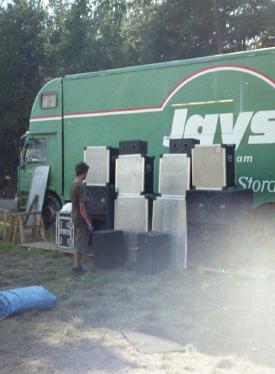
Figure 2 9
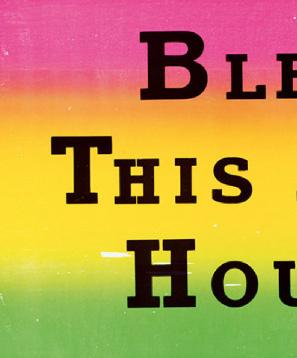
10
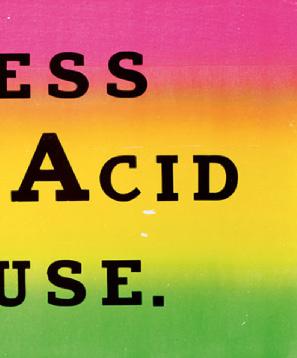
Figure 3 11
Sanctuary: The Unlikely Home of the British Rave
Sanctuary: The Unlikely Home of British Rave is a pop-up exhibition that displays original posters, flyers, artefacts, mer chandise, footage, and more. I discovered the exhibition online and decided to visit to view the memorabilia in real life. The exhi bition gave me a perspective on the culture, displaying and contextualising different pieces of art. Upon walking into the project space, the walls were white, and the space was brightly lit, allowing the memorabilia to showcase itself. Across the main big wall as you walked in presented the ‘Dreams cape’ poster, which was an iconic graphic design piece from the 90s. There was a di verse number of posters, flyers, tickets laid out underneath the glass cabinet, present ing in different shapes and sizes, with con trasted graphic language. Hanging from the ceiling there was a ‘Sanctuary Security jacket’ and placed on a stand there was a black vuvuzela with a multi-coloured string attached. Displaying ephemera, the exhibi tion has created a true sense allowing one to experience the memorabilia first-hand. My main reason for visiting the exhibi tion was because I wanted to experience what it had to offer, whilst also fuelling my ideas to inspire creativity. The exhibition shone a light on the past, and what sense of community the culture presented. Not only does the rave culture scene present
us with a sense of unity, but the different individuals who contributed to the exhibi tion to allow it to open create a sense of community, as they connected to provide materials to showcase such a display.
12
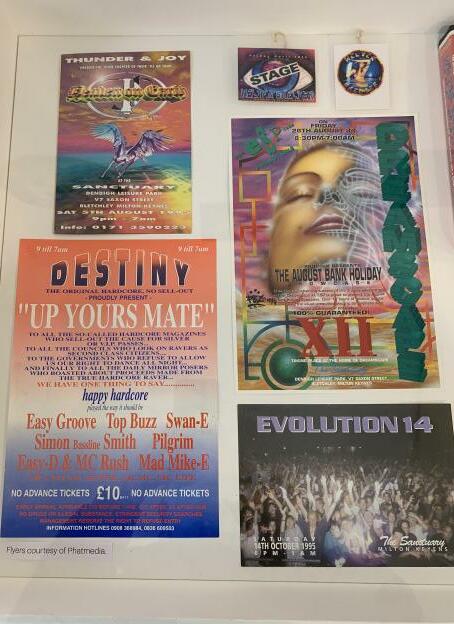
Figure 4 13
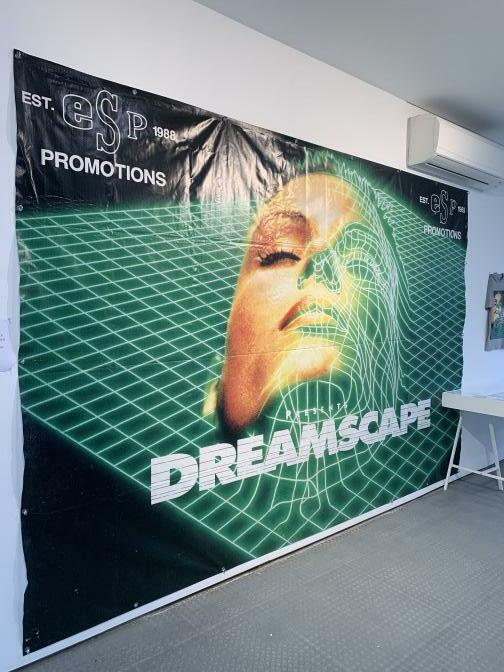
Figure 5 14
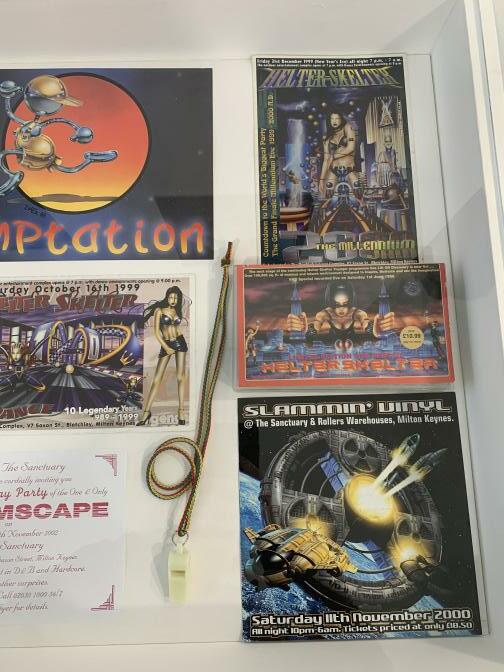
Figure 6 15
Graphic Design
As I’m heavily interested and influenced by 90s rave culture, for my proposed fi nal major project my aim is to re-create posters, flyers, tickets, and stickers from this era. Throughout this study, by using multiple research methods I intend to gain inspiration for my final major project. Sec ondary sources, such as websites, articles, and books, have provided me with the most useful information as they convey the photos and stories of real-life rave culture. Instead of starting from a blank canvas in Adobe Creative Cloud, a previ ous module, creative studio allowed me to explore a range of advanced concepts and practices to experiment with my prac tice further. From this, I plan to work with different mediums such as drawing and painting to test my skills further and to better my creative outcomes. As my de sired outcome for my final major project is to re-create rave posters, flyers, tick ets, and stickers, using materials such as ripped paper, old receipts, contrast ing textures, will build my desired result.
As I’m ‘re-creating’ artwork from the 90s, I wanted to use my talent, whilst also combining it with the inspiration I’ve gained from my research to achieve cre ative outcomes. I intend to create artwork that looks old, somewhat low quality, used, which carries a huge element of nostal
gia. In addition to this, I aim to create work that gives the impression that it’s been pulled down from the attic, and with mul tiple stains on them, causing the ink to run together. The overall outcome of my finished artworks aims to communicate nostalgia, freedom, and desire. I believe by experimenting with various materials and combining my physical and digital skills, I can test my expertise into develop ing a final major project which I propose. ‘So step this way and feast your eyes on 35 years of British club histo ry, told through eyes, pens, scalpels and MacBooks of some of our most gifted de signers’. ‘The logo was culled from an old Letraset book, using traditional Clip-Art, both kitsch and instantly memorable’ (Bill Brewster, Clubbed, 2018). Both sentences extracted from Clubbed educate me with the reality of graphic design in the 90s. To me, graphic design is Adobe Creative Cloud, as I wouldn’t usually experiment with other materials to create my artwork, however, to re-create artwork from the 90s I will test various mediums. Whilst shop ping, I discovered a packet of neon metal lic smiley face stickers, which I purchased to scan using my phone, therefore, I can use them to create. I’ve also considered creating stamps, which again, I can scan it onto my laptop using my phone, and
16
then start my ‘blank canvas’ before using my laptop. By incorporating different ele ments into my graphic design work, will be communicating more of a nostalgic effect.
“When I was first handed a flyer, I’d never seen anything like it, they were our way into the underground culture, had the look and feel of something only we could know and understand. The art work of a flyer can promise pure escap ism just from its design.” These flyers had to look good to get people through the door, too. Psychedelic colours and trippy, surrealist designs dominated acid house and happy hardcore in the ’90s, with rave flyers to match. They’d get stuffed into people’s pockets as they walked out of a club in a daze, ready to be rediscov ered the next morning” (Wickes, 2021).
In the nineties and early noughties, there was a lot of money in the music indus try. Clubbing was huge. Clubs and labels had massive budgets to employ the top de signers in the country. And this showed in the work. The designs in the book all show modernity and beauty. The messaging is clear and concise, and the typography is always beautifully set. The majority of the designs haven’t been dated which shows how special the work is. Club goers wanted to keep them and hang them on the wall (Banks, 1990s rave culture and its influ
ence on graphic design, 2021). Through my participant observation with Rick Banks, I learned that his passion for graph ic design and dance culture is immense. His inspiration from this has enabled him to create incredible work, fuelling my inspi ration. Electronic dance music can evoke strong emotional responses which can create a particular mood or atmosphere, which then promotes creative thinking.
17
“I would come up with a concept that could work as a series, and Ali would either be into it or not. It was one of the first jobs I had out of college, so it allowed me to experiment and develop my own visual language, but it’s safe to say that sci ence and house music played a major role in my thought pro cess” (Bill Brewster, Clubbed, 2018).
18
“Dance music was one of the biggest reasons I got into graphic design. In my teenage years, I loved spending hours in record stores, brows ing vinyl and CDs. In addition to hunting down specific tracks I’d heard on the radio or on Napster, I often bought records based solely on the cover art. I didn’t know it at the time but looking back I was infatuated with the details within the design. I would obsess over the logos and try to redraw them in my schoolbooks. I’d sit in my bedroom and read all the tiny 5-point copy on the packaging for Gatecrasher CDs or ad mire the stunning abstract still life photogra phy on a Renaissance flyer. I’d open the inner booklets and read all the footnotes and memo rise who designed what and who produced what. I would study the grid system counting how many columns compilations and club posters showed.
I soaked up everything and tried to replicate what I’d seen by making mixtapes with accom panying — albeit awful —artwork” (Banks, 1990s rave culture and its influence on graphic design, 2021).
“It was all one love, everyone together. An yone can dance all of a sudden, freedom of expression. Dress down, not up. Converse trainers, smiley T-shirts- a sort of tribal ism took over. Everyone was happy to be the same”. – Pete Tong (Omri, Technostation, 2016)
19
Clubbed
Clubbed is a book written in 2018, by Rick Banks and Bill Brewster. Clubbed is a visual history of club culture featuring log os, posters, flyers, photography, tickets, and lanyards from UK clubs from the last 35 years. Clubbed is a document of one small facet of that, but an important one nonethe less: the look of dance music and it has sold and styled itself (Bill Brewster, 2018). I pur chased this book after discovering it on the internet as I wanted to discover new ideas. This isn’t the kind of book you would pur chase as an eBook or read as a pdf online. Clubbed features a black glittery hardback cover, mimicking the club environment, with the words ‘Clubbed’ through the centre. As soon as I came across this book, I knew I had to purchase it as I wanted to experience the genuine feel and sensation of reading it in person. Clubbed correlates with my passion for graphic design and the rave scene as it features contrasting artwork/graphics by different clubs. Each club that is mentioned in the book has a description of its unique distinct identity, its establishment, where it sits now, and some include the club's in fluences on graphic design/art and who it was inspired by. I purchased this book as I wanted to use it to educate myself on the graphics and artwork of the most famous clubs of the UK and incorporate the graph ics and information to inspire my practice.
20
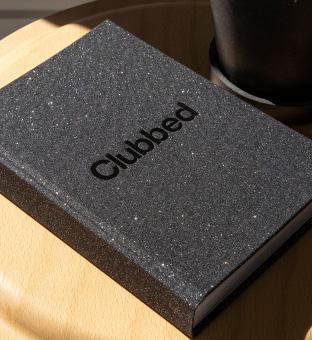
Figure 7 21
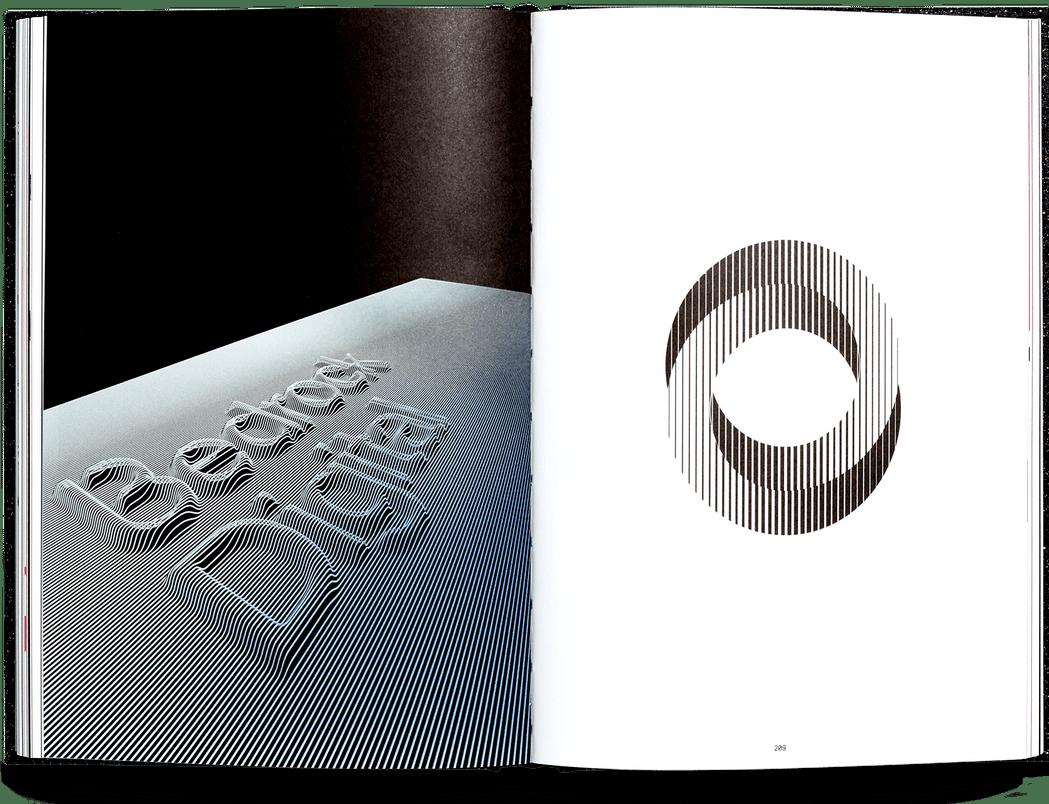

Figure 8 Figure 9 22

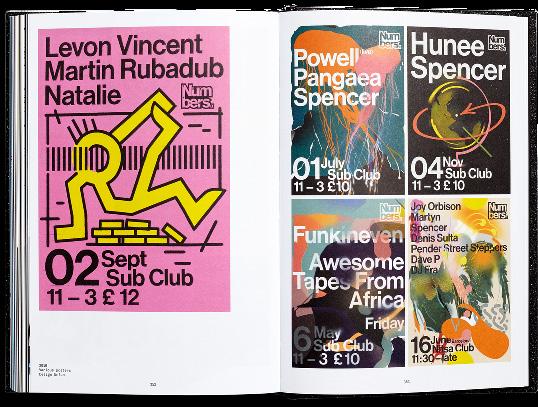
Figure 10 Figure 11 23
Research Methods
To better my understanding of the con text of rave culture and to examine the in fluence behind the graphic design, I have chosen the following research methods: Qualitative Research using participant ob servation, ethnography, phenomenology, and background research. These various methodologies will help me to understand certain Z that I will utilise in my research.
24
Qualitative Research
During my search for appropriate meth odologies for my proposal, I discovered that qualitative research methods will al low me to uncover what I need to know. The phrase qualitative methodology refers in the broadest sense to research that produc es descriptive data, people's own written or spoken words, and observable behaviour. Qualitative researchers are concerned with how people think and act in their everyday lives. As we learn about a setting and how participants view their experiences, we can make decisions regarding additional data to collect on the basis of what we have al ready learned (Steven J. Taylor, 2015).
25
Background Research
By obtaining secondary research, this provides a foundation for my research and educates me on the areas of my study. This allows me to quickly access many websites, publications, and journals from the past, which helps me clarify my research. Find ing and reading specific articles related to my area of interest will aid my research and provide me with a greater understanding of the topic of my study, which allows me to im prove the quality and depth of my research.
26
Participant Observation
I chose to use Participant Observation as a method of research as I wanted to gain a re lationship with respondents and delve deep into their experiences. I chose this meth od of research because I wanted to study the research participants' culture and lan guage. I intend to keep an open mind, which would provide me with opportunities and concepts for my final major project. During a night out, I met a girl named Kimmy and throughout chatting I discovered she used to be a DJ in the early 2000s in Ibiza. She kindly offered to be a participant in my re search, I was chatting with her for around an hour which allowed me to create a relation ship with her and discuss her nostalgic days. My second participant observation was with a graphic designer, Rick Banks. I stum bled across an article on rave culture online, and within the article, Rick's name was men tioned, alongside his personal and business In stagram handle. Owner of “F37 ®” and creator of the book ‘Clubbed’, Rick has a following of 31.4k following, with impressive graphic de sign work. I messaged Rick as my study begins with the exploration of rave culture, and then investigates the graphic design influenced by this. Therefore, I thought he would be a per fect participant to comment on the graphic design behalf, with a touch on rave culture.
27
Ethnography
Ethnography is a method of social science inquiry in which the researcher embeds her self in the ongoing interactions of a particu lar social setting or set of relations in order to understand and explain members’ lived experience (Colin Jerolmack, Approaches to Ethnography, 2018). Once someone choos es to focus on a particular issue and to study through participant observation, beginning an ethnography can be straightforward, you show up somewhere and spend time there (Colin Jerolmack, Approaches to Ethnogra phy, 2018). I picked this method because I'm investigating modern-day rave culture, and by partaking in events in a real-world setting, I'll be able to examine group social interaction first-hand. I'm unable to use ethnographic re search for this because some of my research involves the examination of previous events. However, to study rave culture in modern-day society, I attended “Warehouse Project” and “Hard Dance Music Event” to interact with the scene and capture the scene for myself to create two short ethnographic studies. By ‘becoming part of the group’ I am studying, I’m playing two roles at once: the subjec tive participant and the objective observer.
My first short ethnographic study was visiting Warehouse Project in Manchester. ‘A dominant force in Manchester’s dance music scene’, The Warehouse Project, or WHP as its commonly known, is a series of club nights that take place between September and Jan
uary. Held each year in Manchester, these events feature producers, artists, bands, and DJs from diverse genres of electronic music. I entered the venue around 10 pm and headed straight to a stage to watch a DJ after meet ing up with friends. The venue, which was a large warehouse, was very big and spaced out and cold. I found that a lot of the girls were dressed in a statement to be recognised, such as revealing tight outfits and underwear. I didn’t know many of the artists who were performing at the event, however, I planned to enjoy it and thrive off the atmosphere and al cohol. After around half an hour, I realised that the zip to my small backpack was opened, and my hoodie was falling out. After checking my bag, I realised that my iPhone had been stolen from my bag. After exploring the venue and enquiring about the lost and found, I decided to just enjoy my night and hope that it would be returned to me if it was found. Not only was I upset that my phone had been stolen, but there was a group of boys making homopho bic comments to a friend, causing us to leave to a more tranquil spot. I attended the last DJ set, Charlotte De Witte, to find that the major ity of the people in front of me had their mobile phones out taking photographs or recording the performance. Around 70% of people in the crowd had their phones out recording vid eos or taking photographs, which was inter fering with living in the moment. After eventu
28
ally leaving the venue after searching for my phone again, I was relieved to be going home. My second short ethnographic study was visiting the “Hard Dance Music Event” in Preston, I attended this event with my fe male friend. As we entered the small building to show my ticket, we walked outside to the inside square to discover a fairground ride, a hotdog van, loud music, and flashing lights. Still quite sober, we felt like I’d entered anoth er world. The uproar from the male operating the fairground ride, shouting through the mic, combined with the ecstatic lights and roar ing music created an electric carnival atmos phere. There were multiple different build ings, however, we walked into the first door we saw. Greeted by multicoloured ‘NU Rave’ posters, we entered the ‘Barn’. Upon walking in, we didn’t quite think the atmosphere could get any better. We entered darkness, com bined with strobe lights, a live DJ, and people everywhere. Some people were dressed nor mally, as some were in fancy dress. Shortly af ter walking in, we discovered a male dressed head to toe in bright green, delivering real rave vibes. After we got a drink at the bar, we decided to explore the rest of the venue, therefore, we headed back out to the square and through a different door. Upon arriving at the next building, we were welcomed into a similar situation, however, the venue was huge. As we walked towards the dancefloor, we discovered hanging neon inflatable stars
and led light up snowflakes above a sea of people dancing. The ambiance was exhila rating. Once the main DJs began to play, two dancers emerged from backstage, which be gan performing either side, holding strobe lights in their hands sporting fancy dress, con sisting of furry leg warmers and holographic two pieces. There was also a fire breathing act performing, combined with confetti cannons and a smoke machine dispersing the room. Throughout the night I was constantly ec static, from the beginning until the end. I also found that a lot fewer people were using their phones within the venue, there were hardly any phones with anyone recording videos or tak ing photographs and just living in the moment. Both of my short ethnographic stud ies contrasted vastly. After attending Ware house Project, I was very apprehensive about even going out to a nightclub or a crowded area, after my iPhone was stolen from me. I had to convince myself to attend the Hard Dance Music Event after such a traumatic ex perience at Warehouse Project, however, I’m pleased I attended. Attending both events al lowed me to immerse myself in the situation and observe the people and culture. I was able to experience what raves are like now and par ticipate in my study to observe it first-hand. Although I am unable to experience raves in the 90s first-hand, I’m unable to com pare through my findings. Therefore, using participant observation, I will use the expe
29

Figure 12 30
riences of two individuals to do this. I would get better, more accurate results if I includ ed more people for participant observation. However, I found it difficult to contact people who would be appropriate for my research, therefore, I selected quality above quantity.
During my interview with Rick, he men tioned how mobile phones ruin the atmos phere, I immediately knew before I interviewed him that he wouldn’t mention this. “I don’t think there is a rave culture in the true sense (like there was in the 80s). I do think mobile phones ruin a lot of the atmosphere in clubs. I was happy to hear Fabric banning them. How ever, during the pandemic with the majority of clubs shut down we saw the rise in rave cul ture in terms of people meeting up illegally. In today’s age, clubs are getting shut down more and more due to numerous reasons. And even the ones who aren’t getting shut down, generally don’t have the budgets to employ top design talent. Hence the mishmash you see nowadays. However, clubs like Numbers break this mould and have created some beautiful posters” (Banks, 1990s rave culture and it’s infleuence on graphic design, 2021).
Secondly, discussing rave culture with Kimmy, she speaks: “There is so much nos talgia right now. The music bends space and time and I see so many amazing gigs going on, however, for me, the phone situation grinds my gears. In my day we were free to be what ever we wanted; we could do anything freely not worrying about it coming back on us. That
is priceless and can’t be replicated these days sadly. I have so many conversations where my friends and I talk about feeling sorry for the youth of today and them never being able to experience what we did. Raves/mu sic, they shaped us today” (Moreland, 2021).
The nostalgia and anger between both participants are clear throughout their responses. Raves could be improved mas sively, as the ‘raver generation’ from the 90s potentially wouldn’t attend raves now adays purely for this reason. The compar ison between then and now is the devel opment of technology and mobile phones.
31
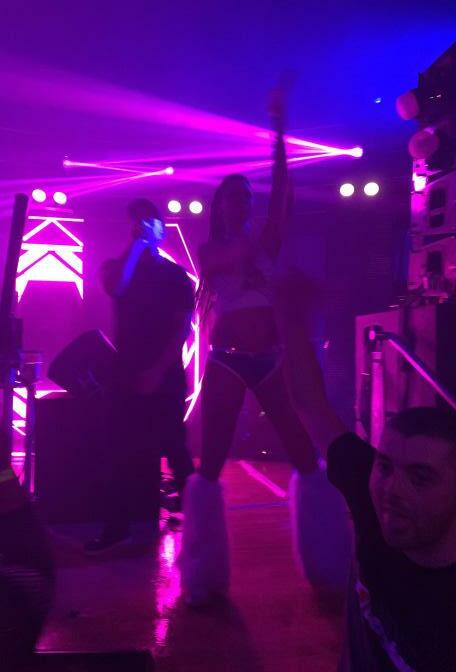
Figure 13 32
Phenomenology
Phenomenology is frequently described as a purely descriptive discipline. It de scribes our experiences just as they are given. Phenomenology is not primarily fo cused on the structure of the mind. Rath er, the proper focus of phenomenal anal ysis is the mind-world. This will become clearer the moment we consider the central concept of intentionality (Zahavi, 2018.)
“I’m too young to have experienced the ‘proper’ raves of the 80s/90s. Look ing back there must have been something magical meeting up in the middle of no where at a certain time without any phones or Ubers. I was even too young to experi ence the super club ’trance’ era. Although I have been to the recent Cream reun ions in Liverpool which were incredible”.
“At the time, I was still too young to go clubbing but I loved the music and embraced the genre like a true fan boy. I bought CD’s, vinyl, posters, merchandise, and collected flyers and magazines. I find it strange that nowadays, this whole experience is often reduced to a tiny square JPEG, often poor ly designed, in the bottom corner of Spotify or iTunes. Admittedly I’m not the biggest clubber in the world but I still buy and listen to dance music every day while I work. And I always look out for its correspond ing design, as they are my two biggest passions. The designs in the book — the very same ones I loved when I was a teenager — formed the designer I am today” (Banks, 1990s rave cul
ture and its influence on graphic design, 2021). Well… I just lived for it. The music main ly drove my enjoyment and watching the DJs which inevitably led me to want to DJ. I still listen to the music now. I guess I had more en ergy then. It was so great to feel part of some thing, surrounded by people. You would meet a stranger and feel like you’d known them forever and dance with them for hours and feel their energy and appreciate the music to gether while just dancing on the spot or on a podium. The love you could feel for a stranger. Strangers would offer you water on a regular basis and chewing gum and you would wake up with tight muscles in your head from chew ing gum for hours and hours. I think living in the north we were spoilt especially as the su per club’s cream and hacienda came about. I used to go to the cream every week and I nev er realised how lucky I was. The bowlers (Man chester) DJs would play their sets on KEY103, and I would just about be able to pick up ra dio reception where I lived. I loved Stu Allen so much… I still listen from time to time now when I’m driving. I would befriend groups of people that I have long lost touch with, and we would sit out in service stations after hours as it got light. It was all part of the scene. I would inevitably feel rough as a dog on Monday, and we would always expect the “Tuesday blues” but then you knew it was nearly the weekend and you would be buzzing to do it all over again” (Moreland, 1990s rave culture and its influence on graphic design, 2021). 33
Aims & Objectives
1. Explore the influence 90s graphic design has on current crea tive practices.
Investigating contemporary artists and designers, I will investigate popular culture and understand the influence.
2. Compare and measure 90s rave culture with modern-day rave culture.
Combining with background research and participant observation, I will use ethnography to attend events which will allow me to deter mine the contrast between both comparisons.
3. Collect and analyse my research to obtain education and in spiration for my final major project.
The research will be collected using different methodologies to influ ence and instigate concepts for my future creative practices.
34
Project Development
My initial approach to my project will be constant experimentation. By testing mul tiple media and materials, I aim to devel op my project by transforming my ideas and deciding which processes are best. By experimenting with my concepts ena bles me to navigate my practice and under stand what does and doesn’t work for me.
35
36
This research aims to explore the formation of subcultures and the acid house movement, rave culture. Secondly, the research intends to examine multiple research methods to build my knowledge of the behaviours, attitudes, and the general characteristics of a group of people. Supporting this, the present findings confirm the outcomes from multiple data col lected throughout the study, enriching the lit erature with organic research, exploring com munity, cultural and artistic contexts. Rave culture is defined as hedonistic and euphoric, and by tapping into the scene personally, I was able to discover this. In addition to this, my study considers the influence rave culture has on graphic design. By engaging with my find ings, I was able to educate myself and under stand the importance the 90s rave and dance scene has on modern designers. The research has helped me build a project I envisioned by understanding personal experiences and in fluences, whilst seeking inspiration through the visual communication I discovered.
Conclusion
37
Acosta, A. (2021, November 30). Haen fler.sites.grinnell. Retrieved from Haenfler. sites.grinnell: https://haenfler.sites.grin nell.edu/subcultures-and-scenes/ravers/ Banks, R. (2021, December 4). 1990s rave culture and it’s infleuence on graphic design. (L. Barnes, Interviewer) Banks, R. (2021, December 4). 1990s rave culture and its influence in graph ic design. (L. Barnes, Interviewer) Banks, R. (2021, December 4). 1990s rave culture and its influence on graph ic design. (L. Barnes, Interviewer) Banks, R. (2021, December 4). 1990s rave culture and its influence on graph ic design. (L. Barnes, Interviewer) Banks, R. (2021, December 4). 1990s rave culture and its influence on graph ic design. (L. Barnes, Interviewer) Banks, R. (2021, December 4). 1990s rave culture and its influence on graph ic design. (L. Barnes, Interviewer)
Bill Brewster, R. B. (2018). clubbed. Bolton: n.d. Bill Brewster, R. B. (2018). Clubbed. In R. B. Bill Brewster, Clubbed (p. 3). Bolton: n.d. Bill Brewster, R. B. (2018). Clubbed. In R. B. Bill Brewster, Clubbed (p. 197). Bolton: n.d. Bill Brewster, R. B. (2018). Clubbed. Bolton: n.d. Colin Jerolmack, S. K. (2018). Approach es to Ethnography. In S. K. Colin Jerol mack, Approaches to Ethnography (p. 12). Oxford University Press, Incorporated.
Colin Jerolmack, S. K. (2018). Ap proaches to Ethnography. n.d: Ox ford University Press, Incorporated. Dawson, C. (2009). Introduc tion to research methods: a practi cal guide for anyone undertaking a re search project. Little, Brown Book Group. Grosskopf, M. (12, February 2020). Form music. Retrieved from Formmusic: https:// www.formmusic.net/musicnews/2019/4/8/ the-revival-of-acid-house-and-rave-artwork Hebdige, D. (1981). Subcultures: The Mean ing of Style . In D. Hebdige, Subcultures: The Meaning of Style (p. 7). Taylor & Francis Group. Jones, A. (2020, July 27). GQ Mag azine. Retrieved from GQ Magazine : https://www.gq-magazine.co.uk/cul ture/article/uk-illegal-raves-2020 Lee, G. (2020, June n.d). Digitalart sonline. Retrieved from Digitalartson line: https://www.digitalartsonline.co.uk/ features/graphic-design/explore-graph ic-design-behind-1990s-rave-culture/ Milestone, K. (1999, December 18). The Guardian. Retrieved from The Guardian: https://www.theguardian.com/theguard ian/1999/dec/18/weekend7.weekend5 Moreland, K. (2021, December 15).
1990s rave culture and it’s influence on graphic design. (L. Barnes, Interviewer) Moreland, K. (2021, December 15).
1990s rave culture and its influence on graphic design. (L. Barnes, Interviewer) Omri. (2016, October 8). Techno Station 38
References
. Retrieved from Techno Station : https:// www.technostation.tv/90s-rave-culture/ Omri. (2016, October 8). Technosta tion. Retrieved from Technostation: https:// www.technostation.tv/90s-rave-culture/ Rowland, O. (2021, May 6). Arts. Re trieved from Arts: https://www.arts. ac.uk/study-at-ual/short-courses/sto ries/top-8-british-youth-subcultures Saylor, D. (2019, June 14). Ranker. Re trieved from Ranker: https://www.ranker. com/list/raves-then-and-now/donn-saylor Steven J. Taylor, R. B. (2015). Introduc tion to Qualitative Research Methods. New York: John Wiley & Sons, Incorporated. Stone, B. (2017, February 27). itsni cethat. Retrieved from itsnicethat: https://www.itsnicethat.com/fea tures/artist-mark-leckey-270217
Stone, B. (2017, February 27). Itsni cethat. Retrieved from Itsnicethat: https://www.itsnicethat.com/fea tures/artist-mark-leckey-270217
Stone, B. (2017, February 27). Itsni cethat. Retrieved from Itsnicethat: https://www.itsnicethat.com/fea tures/artist-mark-leckey-270217
Technostation. (2016, October 8). Re trieved from Technostation: https:// www.technostation.tv/90s-rave-culture/ Walker, A. (2020, August 4). Brighton Journal. Retrieved from Brighton Journal: https://bright onjournal.co.uk/the-history-of-illegal-raves-
and-why-theyve-been-making-a-comeback/ Warwick, O. (2021, January 21). djmag. Retrieved from djmag: https://djmag. com/longreads/let-us-be-your-fantasyhow-fantazia-brought-uk-rave-masses Watson, G. (2017, May 10). Port Mag azine. Retrieved from Port Magazine: https://www.port-magazine.com/fash ion/a-brief-history-of-british-subcultures/ Wickes, J. (2021, October 25). The Face. Re trieved from The Face: https://theface.com/ culture/old-school-rave-flyers-phatmediajungle-acid-house-happy-hardcore-nightlife Williams, P. (2018, April 18). Red bull. Retrieved from Redbull: https:// www.redbull.com/gb-en/his tory-of-the-acid-house-smiley Zahavi, D. (2018.). Phenomenolo gy: The Basics. n.d: Taylor & Francis.
39
Image References
Figure 1: Ted, T. S.. (2020). Youth Cul ture, Rave. Another Mag. https://www. anothermag.com/art-photography/gal lery/11176/spiralled-by-seana-gavin/2
Figure 2: Ted, T. S. (2016). “Setting up a sound system at a rave”. Another Mag. https:// www.anothermag.com/art-photography/ gallery/11176/spiralled-by-seana-gavin/12
Figure 3: Emily, E. G.. (2016). “Bless This Acid House” poster by Jeremy Deller. Eye on Design. https://eyeondesign.aiga.org/what-rave-cul ture-is-teaching-modern-graphic-designers/
Figure 4: Flyers and posters at Sanctu ary: The Unlikely Home of the British Rave
Figure 5: Dreamscape poster at Sanctu ary: The Unlikely Home of the British Rave
Figure 6: Flyers and posters and ac cessories at Sanctuary: The Un likely Home of the British Rave
Figure 7: Rick, R. B.. (2016). “Clubbed the book”. Face37. https:// www.face37.com/shop/clubbeda-visual-history-of-uk-club-culture
Figure 8: Rick, R. B.. (2016). “Clubbed the book”. Face37. https:// www.face37.com/shop/clubbeda-visual-history-of-uk-club-culture
Figure 9: Rick, R. B.. (2016). “Clubbed the book”. Face37. https:// www.face37.com/shop/clubbeda-visual-history-of-uk-club-culture
Figure 10: Rick, R. B.. (2016). “Clubbed the book”. Face37. https:// www.face37.com/shop/clubbeda-visual-history-of-uk-club-culture
Figure 11: Rick, R. B.. (2016). “Clubbed the book”. Face37. https:// www.face37.com/shop/clubbeda-visual-history-of-uk-club-culture
Figure
Figure
Figure
Figure
Figure
12: Warehouse Project
13: Hard Dance Music Event
14: Mind Map of initial project ideas
15: SWOT Analysis of project
16: Gantt Chart, project management 40
Appendices
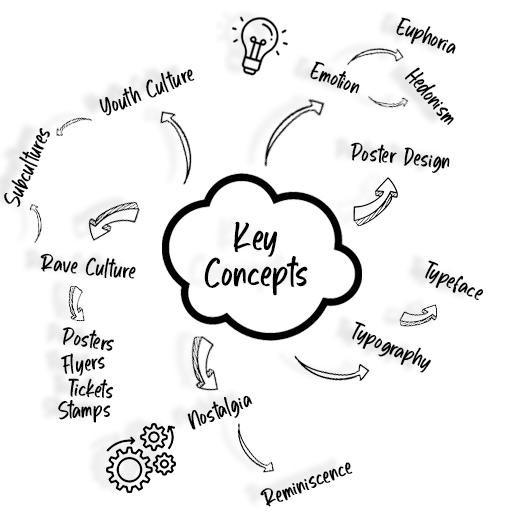
Appendix A
Figure 14
41
SWOT Analysis of Project Proposal
Strengths Create sense of nostalgia and community Skill level Weaknesses Gaps in knowledge and expertise Timescale and deadlines Threats Change in government guidelines due to COVID-19 Opportunities Learn more about the culture Improve my skills and practice Create relationships for future practice and contacts Figure 15 Appendix B
42

Appendix C Gantt Chart of Project Development Figure 16 43
Appendix D
Interview with Rick Banks (R=Rick) (I+Interviewer)
I: What was your overall experience from raves?
R: I’m too young to have experienced the ‘prop er’ raves of the 80s/90s. Looking back there must have been something magical meeting up in the middle of no where at a certain time without any phones or Ubers. I was even too young to experience the super club ’trance’ era. Although I have been to the recent Cream reunions in Liverpool which were incredible.
I: As my main focus on this study is graphic design, throughout rave culture in the 90s, could you comment on this? What was it like? Were you intrigued by flyers/posters/tickets?
R: Dance music was one of the biggest rea sons I got into graphic design. In my teenage years, I loved spending hours in record stores, browsing the vinyls and CDs. In addition to hunting down specific tracks I’d heard on the radio or on Napster, I often bought records based solely on the cover art. I didn’t know it at the time but looking back I was infatuated with the details within the design. I would ob sess over the logos and try to redraw them in my schoolbooks. I’d sit in my bedroom and read all the tiny 5-point copy on the pack aging for Gatecrasher CDs or admire the stunning abstract still life photography on a Renaissance flyer. I’d open the inner book
lets and read all the footnotes and memorise who designed what and who produced what. I would study the grid system counting how many columns compilations and club posters showed. I soaked up everything and tried to replicate what I’d seen by making mix-tapes with accompanying — albeit awful — artwork!
I: What do you think “rave culture” is like in modern day society? What is the difference between then and now?
R: I don’t think there is a rave culture in the true sense (like there was in the 80s). I do think mobile phones ruin a lot of the atmosphere in clubs. I was happy to hear Fabric banning them. However, during the pandemic with the major ity of clubs shut down we saw the rise in rave culture in terms of people meeting up illegally.
In the ninety’s and early noughties there was a lot of money in the music industry. Clubbing was huge. Clubs and labels had massive budg ets to employ the top designers in the coun try. And this showed in the work. The designs in the book all show a modernity and beauty. The messaging is clear and concise and the ty pography is always beautifully set. The major ity of the designs haven’t dated which shows how special the work is. Club goers want ed to keep them and hang them on the wall.
In today’s age clubs are getting shut down more and more due to numerous rea 44
sons. And even the ones who aren’t get ting shut down, generally don’t have the budgets to employ top design talent. Hence the mish-mash you see nowadays. How ever, clubs like Numbers break this mould and have created some beautiful posters.
Interview with Kimmy Moreland
(K=Kimmy) (I=Interviewer)
I: What was your overall experience from raves?
K: Well…. I just lived for it. The music mainly drove my enjoyment and watching the DJs which inevitably led me to want to DJ. I still listen to the music now. I guess I had more energy then haha. It was so great to feel Part of something. Surrounded by people. Wheth er people agree or not the drugs were a very important part of the raves. You would meet a stranger and feel like you’d known them forever and dance with them for hours and feel their energy and appreciate the music to gether while just dancing on the spot or on a podium. The love you could feel for a stranger. Strangers would offer you water on a regular basis and chewing gum and you would wake up with tight muscles in your head from chew ing gum for hours and hours. I think living in the north we were spoilt especially as the su per club’s cream and hacienda came about. I used to go to the cream every week and I nev er realised how lucky I was. The bowlers (Man
chester) DJs would play their sets on KEY103 and I would just about be able to pick up radio reception where I lived. I loved Stu Allen so much… I still listen from time to time now when I’m driving. I would befriend groups of people that I have long lost touch with, and we would sit out in service stations after hours as it got light. It was all part of the scene. I would inev itably feel rough as a dog on Monday, and we would always expect the “Tuesday blues” but then you knew it was nearly the weekend and you would be buzzing to do it all over again.
I: As my main focus on this study is graphic design, throughout rave culture in the 90s, could you comment on this? What was it like? Were you intrigued by flyers/posters/tickets?
K: The flyers were so important but in the early days I don’t really recall keeping many. I would probably clutch them for hours in a right state as they were given to me as I left. For me what was more important was the mix tapes that people would record off the radio and then you would rerecord for yourself. Lat er I loved the art on the vinyl sleeves but would equally be excited about a plain white label.
I: What do you think “rave culture” is like in modern day society? What is the difference between then and now?
There is so much nostalgia right now. The mu sic bends space and time and I see so many 45
amazing gigs going on… However, for me the phone situation really grinds my gears, in my day we were free to be whatever we wanted. We could do anything freely not worrying about it coming back on us. That is priceless and can’t be replicated these days sadly. I have so many conversations where me and my friends talk about feeling sorry for the youth of today and them never being able to experience what we did. Raves and music, they shaped us today.
46

















